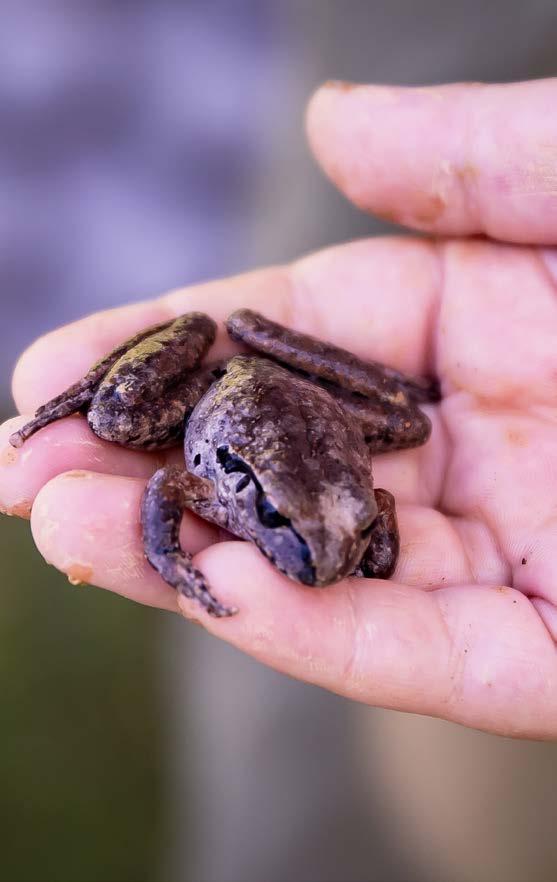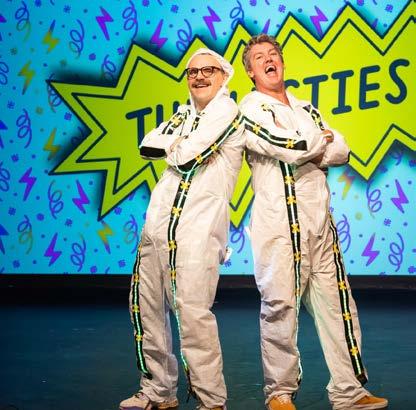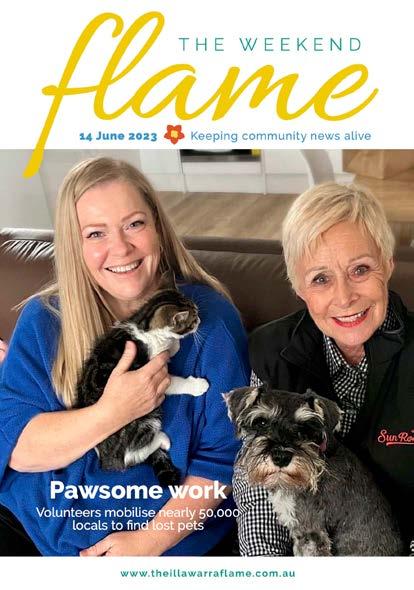




Tickets $40 - $15 | BOOKINGS via Humanitix site: ‘ABDIEL & NEWMAN | p: 0408422427 e: inspiremusica

A FREE CONCERT SERIES donations appreciated SCAN TO BOOK NOW OR GO TO HUMANITIX MUSIC & TEA WOLLONGONG ART GALLERY



Presents the musical at IPAC

What’s the buzz? The first musical by Andrew Lloyd Webber and Tim Rice to be produced for the professional stage, Jesus Christ Superstar has wowed audiences for over 50 years. The rock opera is set against the backdrop of an extraordinary and universally known series of events but seen, unusually, through the eyes of Judas Iscariot.
Did you know? The Illawarra Flame is named for one of the region’s most spectacular trees
To celebrate National Tree Day this Sunday, Wollongong City Council invites the community to plant native trees, shrubs, and grasses at planting events in Berkeley, Figtree, and Russell Vale.
Wollongong City Lord Mayor Councillor Gordon Bradbery AM said everyday should be tree day given the evergreen benefits they provide.
“Trees and plants cool our suburbs, reduce pollution, make our natural areas beautiful and provide food and shelter for native wildlife,” said Cr Bradbery.
“They also play an important role in stabilising river and creek banks and our coastal foreshore to prevent erosion during flooding and storms.
The story, told entirely through song, explores the personal relationships and struggles between Jesus, Judas, Mary Magdalene, his disciples, his followers and the Roman Empire. The iconic 1970s rock score contains such well-known numbers as ‘Superstar’, ‘I Don’t Know How to Love Him’ and ‘Gethsemane’. Opens tonight at IPAC.

26 July Handsome Young Strangers and The Go Set in Concert
July 30 I Hate Networking workshop
8-10 August A Place in the Sultan’s Kitchen 16 August The Gruffalo 17 August Illawarra Family History and Heritage Fair 21 August Railway Sessions – Open Mic
“As the impacts of extreme weather increase, planting more trees and plants is something simple we can all do now to help create a better future.”
Council will be hosting three plantings on Sunday: Holborn Park on Lake Illawarra, Berkeley; Byarong Creek, Figtree; and Cawley Park, Russell Vale. Click here for details.


1 Sept Fancy Women’s Bike Ride
7 Sept Music 4 Medicine
5-15 Sept
The Mousetrap
20-22 Sept Folk by the Sea
Click here for more events
By Jeremy Lasek

Central to the Allyship Day design is Uluru, cradled within a coolamon, symbolising collective commitment to the Uluru Statement
Thursday, 8 August is International
Allyship Day.
This special day was established last year, ironically just a matter of weeks before the referendum which failed to give Indigenous Australians a Voice to Parliament.
Coming out of the referendum, and having had time to digest the result, a group of organisations and individuals felt it was time to put the disappointment of 14 October 2023 behind us, and to regroup, aiming for a brighter future by working together towards a common goal.
Leading the way are the Allies for Uluru who have joined forces with the University of Wollongong’s Woolyungah Indigenous Centre to present the first National Allyship Day Summit.
As a Friend of Woolyungah, I’m excited to be a part of the organising group and keen to establish this summit as a significant annual event on our calendar.
The impressive list of speakers include 2024 Wollongong Citizen of the Year, Aunty Barbara Nicholson; Voice advocate and author, Thomas Mayo; 2021 NSW Australian of the Year and social justice advocate, Craig Foster; South Coast Labour Council leader, Arthur Rorris; 2023 Australian of the
Year Local Hero, Amar Singh; and leading public health advocate, Dr Summer May Finlay.
The summit will bring back together many of the Illawarra locals who campaigned so passionately for a Yes vote during 2023. The event will explore key themes of Voice, Treaty and Truth and how allies can support the implementation of the Uluru Statement from the Heart.
“Through this event we will aim to foster collaboration, understanding, and solidarity among Aboriginal and Torres Strait Islander leaders and ally organisations in pursuit of recognition and justice,” said Michael Anderson from the Allies for Uluru.
The four main objectives of the summit are to: Raise Awareness; Build Dialogue; Build Community; Inspire Action. Executive Director of Indigenous Strategy at UOW’s Woolyungah Indigenous Centre, Jaymee Beveridge, said Allyship Day presented an opportunity to bring people together to recognise the importance of standing up for one another, fostering inclusivity, and building bridges of support and understanding.
“Allyship is about being a friend, an advocate, and a source of solidarity and strength,” Jaymee said.
The Allyship Summit is free to attend


By TVC secretary Annette Jones

OnSunday, 21 July the TVC held its Annual General Meeting. The executive team (pictured on front cover) was re-elected unopposed:
• President - Ray Smith
• Vice President – Elliot Stein
• Treasurer – John Mebberson
• Secretary – Annette Jones
• Assistant Secretary – Tony Horneman
• Public Relations Officer – Stephen Le Bas.
At the conclusion of the AGM a Meet the Candidates Forum was held to allow the community to get to know the candidates for the upcoming Council elections on 14 September. Each candidate outlined their background, skills and vision for Wollongong.
Cr. Tania Brown (Labor) – Grew up in Unanderra; Deputy Lord Mayor for 5 years; been working at UOW for 15 years; background in government; member of a number of committees; wants to deliver a customer focused Council, one that responds in an acceptable timeframe; noted a need for more footpaths, parks and playgrounds; stated due to lack of available land it is not appropriate to increase development in the northern suburbs.
Cr. John Dorahy (Liberals) – Grew up in Wollongong; Councillor for 13 years; Deputy Lord Mayor on three occasions; has a sporting background; works as General Manager in Sales; worked in the hospitality and club
industry; relinquished his board membership on various clubs; wants to increase and improve the engagement with residents and business owners to understand the community challenges; wants to reinvigorate businesses and small villages, such as Thirroul; increase the number of footpaths; increase funding to sporting infrastructure to improve facilities for all genders.
Jess Whittaker (Greens) – Grew up in Bulli before moving to Port Kembla; works as a paramedic; wants to see Wollongong reach its full potential; need more investment in footpaths and cycleways; wants to increase affordable housing; make Wollongong a vibrant place in which to live; hopes to ease cost of living pressures by holding more Council events, making pools free and building more skate parks; wants to build more community gardens; continue to push for the removal of shark nets off our coastline.
Cr. Richard Martin (Labor) – Moved to Wollongong 13 years ago; regularly attends the TVC, NIRAG and Neighbourhood forums; been working with Maryanne Stuart and TfNSW on an alternative route to and from Thirroul; successfully lobbied Council to apply to NSW Government to become part of a noise traffic study; wants to make sure that residents are looked after to minimise their risk of flooding and to
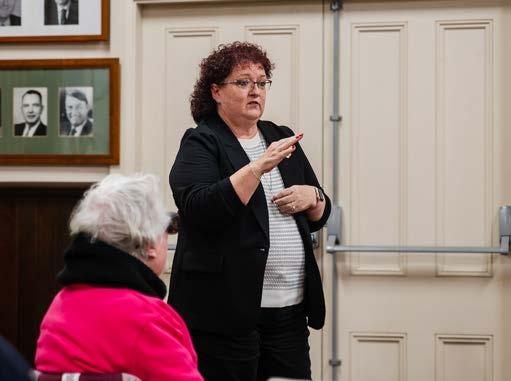

educate people near waterways of their rights and responsibilities.
Dan Hayes (Labor) – Worked as a Councillor for 7 years while living in Wagga Wagga; believes experience is important; is a psychologist working in suicide prevention; stated council needs to keep connected with the community and to look after footpaths, roads, libraries and rubbish removal.
Cr. Cameron Walters (Liberals) – Lives in Helensburgh; pushed for and achieved installation of CCTV on Bald Hill; wants to increase parking availability in the city; identified the need to increase use of parkland; wants to increase funding from the State Government.
Philip Clifford (Liberals) – Born and bred in Thirroul; attends TVC meetings; identified the need for more footpaths citing the example of Point Street Bulli which has waited 25 years for a footpath; wants to see improvement in flood mitigation, noting the need for clearance of retention basins and drains.
Jess Whittaker (Greens) – Identified the need for safe streets for children; more cycleways and footpaths required; need to keep young people entertained, hence need for a skatepark; remains connected to the northern suburbs.
Martin Cubby (Greens) – Grew up in Sydney and went to UOW; coaches a local soccer team; been a Union Organiser for 20 years; wants to make Wollongong a walkable city, hence the need for cycleways and footpaths.


“A Meet the Candidates Forum was held to allow the community to get to know the candidates for the upcoming Council elections on 14 September”
– Annette Jones
By Jeremy Lasek

Prepareyourself to be bombarded with electoral material over the next couple of months as we edge closer to the local council elections in Wollongong.
It’s fair to say being a councillor, dealing with grassroots community issues on a daily basis, can be a thankless job. But it can also be rewarding – not financially, but in helping shape the future of our city.
In many ways, our elected councillors represent us on issues that impact us on a daily basis, starting with the ‘three Rs’ –roads, rates and rubbish. Our council also looks after our parks, gardens and sporting fields, public swimming pools, our drainage and stormwater systems, footpaths and cycleways and our much-loved libraries. It also presents and
promotes tourist, sporting and cultural activities, citizenship ceremonies and civic award programs.
The countdown is well and truly on for the next NSW Local Government elections, which will take place on Saturday, 14 September.
There’ll be some new faces on Wollongong City Council. At this time, two current councillors, Cath Blakey and Mithra Cox, have announced they’ll not be standing, making way for new blood. The retirement of Gordon Bradbery also means we’ll have a new Lord Mayor for the first time 2011.
The clock is ticking if you, or someone you know is thinking of running for the

“People will expect to see you at community events and meetings, and that you’ll be accessible to meet with those requiring council support at a mutually convenient time.”
– Jeremy Lasek
upcoming election, seeking one of the 12 vacancies across three wards. Nominations open on 5 August and close on 14 August.
While no formal qualifications are required, training is available for all elected councillors. Having spent more than 40 years observing and working closely with elected councillors and state and federal MPs, here are a few tips for anyone considering throwing their hat in the ring.
Time: Being a councillor requires a serious time commitment. There are official meetings and briefings, you’ll need time to read council papers and public submissions and you can expect constituents will want to talk to you and meet you (and it won’t necessarily be Monday to Friday 9-5).
Accessible: Once you’re elected, to some extent you become ‘public property’. People will expect to see you at community events and meetings, and that you’ll be accessible to meet with those requiring council support at a mutually convenient time.
Diverse: It’s important that the council is represented by a diverse group of individuals. It is equally important that elected officials have an interest in a diverse range of issues (i.e. not a single-issue focus).
Informed: Councillors will be expected to be diligent in getting up to
speed on significant issues across the city, and particularly in their ward area, so as to be able to make informed decisions.
Open-minded: Everyone elected to council brings a different skill set and life experience. It’s important that councillors are willing to listen to a diversity of views and be open to changing their mind should there be a compelling reason to do so.
Communication: This may be the single most important strength for a councillor. The ability to communicate in written and verbal form is essential. Councillors will be expected to speak at meetings, and to the media, and to provide written responses to the public on a range of issues.
Responsive:The business of Council never stops, and the public has an expectation that councillors will always represent their best interests. Councillors will be expected to be on the ball and provide their input, comments and feedback to the community and council in a timely manner.
If all of the above hasn’t scared you off then you might want to dig a bit deeper. The best place to get all the information you need about standing for council is on the NSW Office of Local Government’s website
The NSW Electoral Commission also has more information on becoming a candidate.

By Emma Rooksby of Growing Illawarra Natives

“The flat seed pods of Rainforest Senna, growing in a natural area in Mount Pleasant.”
– photo by Emma Rooksby
It’sa sad fact that the state of the environment in New South Wales is declining. And it can be pretty dispiriting to think about the number of species and ecosystems that are in trouble. But we can turn things around, literally and figuratively, if we think about how close we are to some of those species and what we can do for them.
Data from the Threatened Species in Cities database developed by staff at the University of Melbourne provides accessible and engaging information on how many threatened species are living among us.
For Wollongong, the database lists 10 threatened plants and a massive 26 threatened animals, including sea birds, frogs, birds and even the koala.
Each and every one of us can do things that make the prospects of these species brighter.
For example, right now, in rainforest pockets around the Illawarra (or as far south as Balgownie at least), the beautiful little shrub known as Rainforest Senna (Senna acclinis) is flowering or fruiting.
It’s got gorgeous bright yellow flowers that attract a wide range of insect pollinators. If you’re wandering around in bushland along the escarpment, you
might see Rainforest Senna flowering right now.
The bright yellow flowers of Rainforest Senna (Senna acclinis) are appealing to humans and to native pollinators such as bees. This flower pictured below has attracted a native bee, Lipotriches australasica. (Image by Elena Martinez.)
But – a word of warning! There are many introduced species of Senna growing in this region, and they are well-known as horrible weeds, spreading rapidly and dominating the rainforest understorey if not kept in check. So if you see a beautiful yellow flower, it might equally be Easter Cassia (Senna pendula. var. glabrata) or Winter Senna (Senna septemtrionalis). These species are common and widespread, and a lot of effort is put into eradicating them. So… what to do? Pay close attention to the features of any Senna plant you see. In particular, the seed pods. Pods of the endangered Rainforest Senna are flat, while those of the introduced Senna species are round. The picture below shows the flat Rainforest Senna seed pods. Keep an eye out when you’re walking in bushland, or even in your garden. You might have an endangered species on your hands.



By Amanda De George

Artist, bird nerd, strength profiler, nature lover, business coach, academic and bush spiritualist; Rebecca Lea is a woman of many passions and talents, and a fascinating blend of science-based, logical thinking and spiritualism. She uses her academic background in positive psychology to create unique jewellery and in her work as a bush spiritualist. Connection is at the heart of everything she does. Connection with nature and connection with others.
She’s also very lovely, which I discover as we huddle over chai during the recent wintery blast.
The Birds and The Beach, which was launched earlier this year, ‘blends science and ancient wisdom’ through re-earthing, mindfulness and Bec isn’t afraid to pull out a tarot card or two. “It
does get a bit woo-woo and I’m happy with that,” she said.
White Clay Mountain is the home for her wildly popular, small-batch polymer clay and gemstone jewellery stocked throughout the region (you can find her stockists here).
Each collection is inspired by nature and I first discovered her work when I purchased a pair of polymer clay earrings at the Wollongong Art Gallery. I instantly fell in love with the bright pink and red colourway, which I found out later was inspired by seaweed washed up on McCauley’s Beach, a beach I regularly walk on.
I thought that was a nice little coincidence and it turns out there’s an air of synchronicity about everything she does; small moments that have changed the course of her life. A bout of postnatal
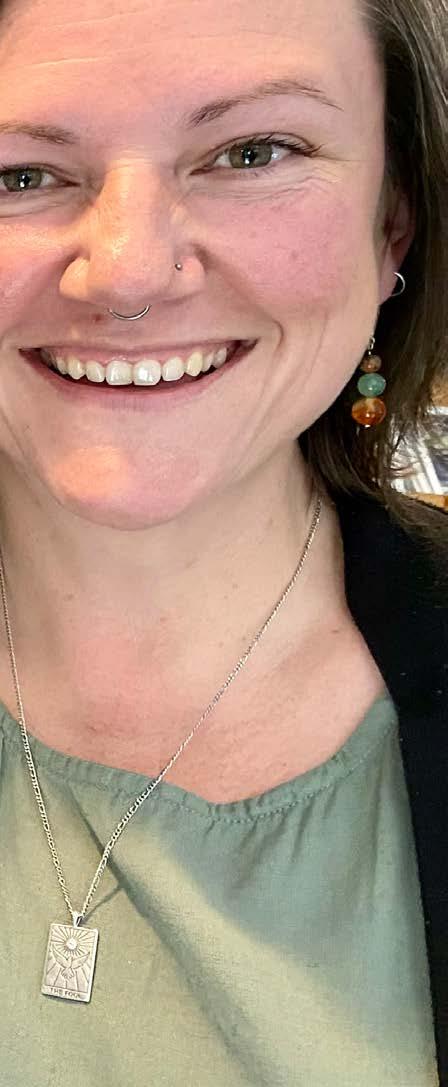
“I
have a bird nerd father. He taught me how to identify birds around us by sight and sound.”
– Rebecca Lea, whose design for the earrings (pictured at right) was inspired by her father’s photo of a Green Rosella
depression after the birth of her son led to Rebecca needing to rekindle her connection with her daughter.
“I’ve always been creative,” she said, “and I knew from my study that tactile creativity, that’s really good for wellbeing.”
Setting out with no real idea of what form that creativity would take, she ended up with a kit to make unicorns from polymer clay, an activity she knew her daughter would love – because, well, unicorns – but that would also help improve her own mental health.
“We made this little unicorn together and it was horrific! My unicorn was pathetic but she loved it,” Bec said.
“And then I had all this clay left over.”
Bec began making earrings, first as a creative outlet, then as gifts and finally White Clay Mountain was born.
“I knew I wanted it [the jewellery] to be nature-inspired and with my tie to the Illawarra I wanted it to inspired by my local environment,” she said.
This is where that meshing of what Bec refers to as her “two very different sides” brings a unique perspective to her work. She spends time in nature to boost her wellbeing, an activity backed by science, but it’s also how she gets inspiration for her jewellery collections. Each is inspired by an encounter she has had with an animal or a plant. She then spends time researching the species, which adds another layer of meaning to
the final pieces.
Bec hopes that these nature-inspired pieces will in turn help the wearer.
“The idea is when you’re wearing the jewellery you get the same experience from nature. You’re thinking of nature, your brain goes, ‘oh nature’ and your wellbeing improves,” she said.
“I didn’t create my businesses as businesses, I’ve created them as an extension of me. These are the things I like doing and I want to take you with me.
“I want to be able to inspire people, empower people to be able to follow the things that feel right to them.”
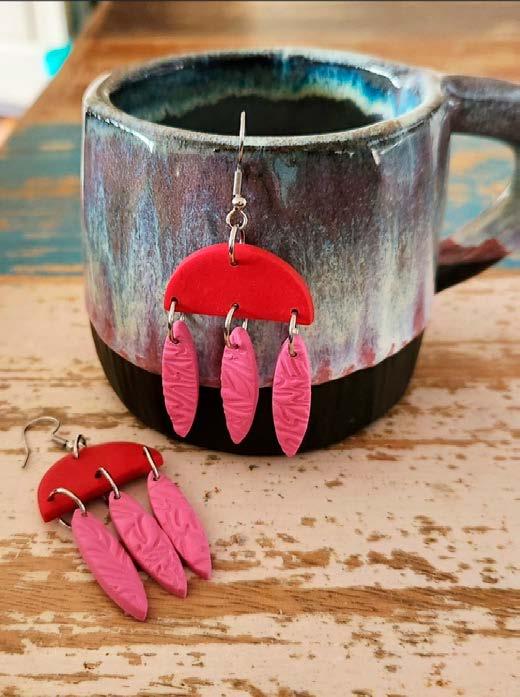

By Genevieve Swart
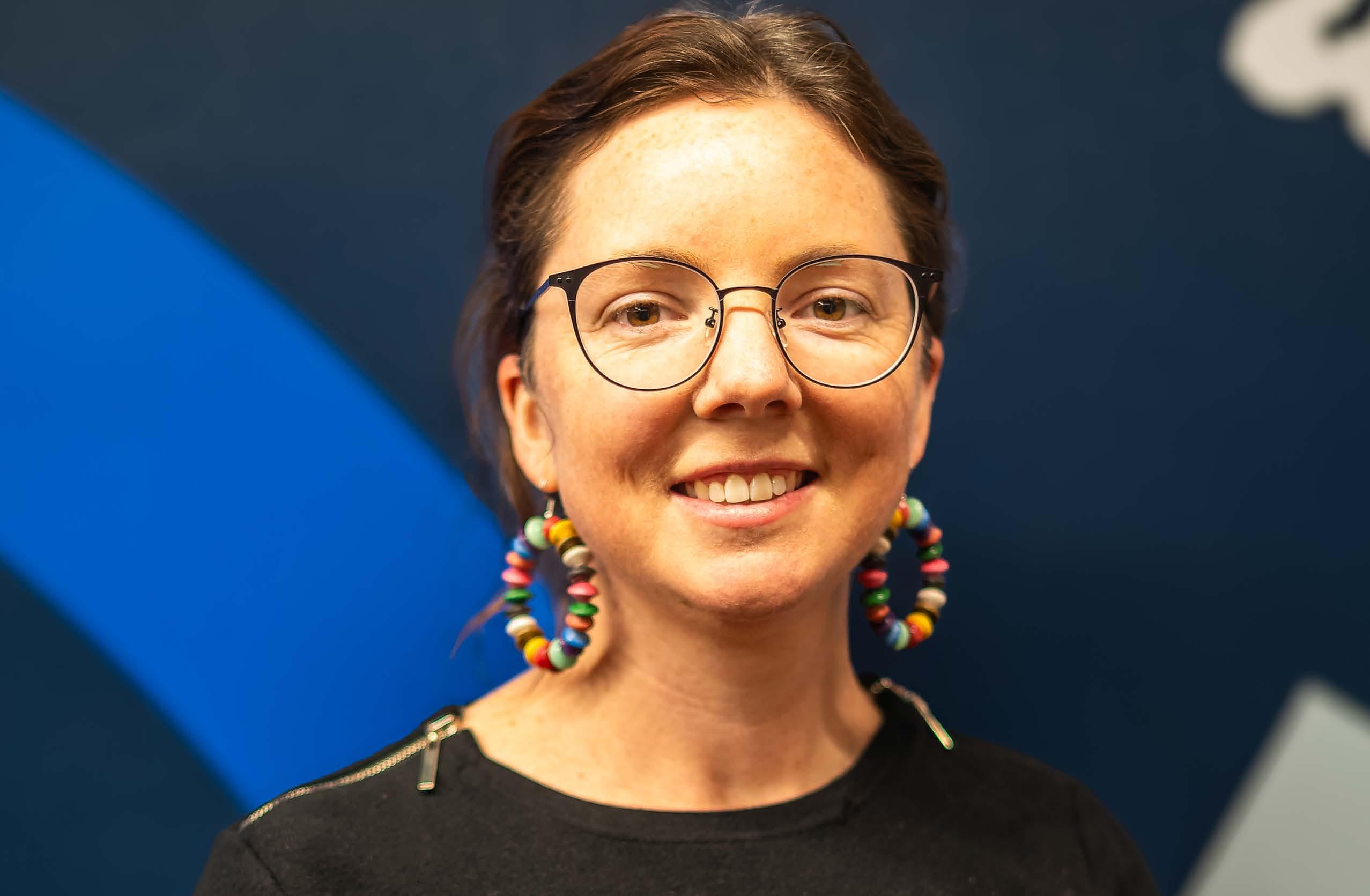
Social enterprises are on the rise as everyone from urban farmers to toilet paper manufacturers is choosing an operating model that puts people and planet first.
Membership of the Social Enterprise Council of NSW and ACT (SECNA) has more than tripled in the past 18 months, says the organisation’s CEO, Illawarra local Kylie Flament.
“We had just over 100 members, a mixture of mainly social enterprises, but also funders, councils, state government folks, individuals – people that support social enterprise. We’re at 380 now. It’s amazing and it’s so good to be able to connect and engage everyone and to be a voice for them.”
Wollongong social enterprises also
include Flagstaff, Greenacres and the Disability Trust. “Greenacres is really having a strong focus on that now – so they’ve just started a whole homewares business, which is really cool.”
Before joining SECNA, Kylie was the general manager of local social enterprise Green Connect. She left that demanding role in 2022, ready for a break. But soon after Kylie found a new and exciting way to build on her experience, thanks to a trip to the Social Enterprise World Forum in Brisbane. “I was between roles and I just went, ‘Oh my God, these are my people. This is my tribe.’
“I come from the business world, but I have a burning desire to leave a cleaner, greener, fairer, kinder world behind. And that’s what social entrepreneurs do.”
Social enterprises take off Around Australia, the sector is booming. “When I came into the role at SECNA, I thought, we’ve got this uphill battle trying to get the idea of social enterprise into the mainstream, which is what it felt like at Green Connect,” Kylie says.
“And then suddenly just in the last 18 months since I’ve been in the role, we’ve had the United Nations come out, recommending that all countries get behind social enterprise as the model for economic development into the future. The European Union has done the same thing. OECD is developing frameworks to show governments how to support social enterprise in a really meaningful way. So globally, suddenly there’s this laser focus on social enterprise as a better way of doing business.”
The Australian government is on board too. “Social enterprise has been called out in the employment White Paper. So, a once in a generation report about employment in Australia saying this is the way forward, the Workforce Australia report.
“Something that has felt like we are beavering away and we’re on the fringe is now becoming very mainstream, and that’s incredibly exciting.”
Social enterprise certification recognises a business’s purpose but does not change its legal structure, Kylie explains. “Social enterprise is a business for good. They trade like any other business, but they exist specifically to make the world a better place.”
“I get approached a lot by either businesses or charities saying, tell me more about social enterprise… Why would I become one? How do I become one? They’re often seeing the writing on the wall that this is where both policy and government funding is heading and what consumers want.”
Time to put people & planet first “I think we’ve reached a point in human history where we recognise that what we’ve been doing for the last … let’s say 200 years since the Industrial Revolution … has not served us well, and we cannot continue to do this,” Kylie says.
“Every measure of planetary boundary that you look at, we’re exceeding. We cannot keep living as if resources are infinite and we cannot just keep on mining the planet and we cannot keep on treating some people really well and some people really poorly.
“We’ve woken up to the fact that humans have, in a very short space of time, made the planet dirty and dangerous. And we’ve increased inequalities. And so socially and environmentally we are at a crunch point.”
To find out more, Kylie is inviting everyone to the free Social Enterprise Festival on August 3 at UTS in Sydney.
“Bring your neighbour, bring your colleague, bring your children, your grandmother. [There is] something for everyone. There’s market stalls, there’s talks, there’s workshops, it’ll be awesome.”
“Something that has felt like we are beavering away and we’re on the fringe is now becoming very mainstream, and that’s incredibly exciting.”
– Kylie Flament, SECNA CEO


By Genevieve Swart

“I’ve been working in community services for 25 years and we’ve never seen this degree of food poverty and energy poverty”
–
Nicky Sloan, CEO of Community Industry Group
It has been a cold, wet winter – bad for sickness, bad for mould and bad for energy bills.
“I’ve been working in community services for 25 years and we’ve never seen this degree of food poverty and energy poverty,” says Nicky Sloan, CEO of Community Industry Group, the peak body for the not-for-profit sector across southern NSW.
“One of the things that we don’t realise in Australia is that more people die of the cold than die of the heat. It’s because our houses are not very well set up for that, and that’s why we use so much energy in the winter, trying to keep these houses warm.
“Often people on the very lowest income live in the very least wellinsulated homes, have the least energy-efficient appliances, and that’s why energy poverty really kicks in at this time of year.”
Nicky, who is based in Port Kembla, says Illawarra neighbourhood centres are swamped with people in need. “They’re oversubscribed anyway, but at this time of year, in particular, because people’s energy bills are so bad.”
Some people are using butane heaters to stay warm and to cook.
“We are hearing of people doing that because it’s cheap, but unfortunately, it’s
really, really unsafe,” Nicky says.
“I’ve got lots of examples of older people who are making some pretty diabolical choices.
“We have people going inside earlier than afternoon, shutting all the doors and windows, sitting in the dark, wearing a blanket to try and stay warm, because they’re afraid to use any form of heating.
“And then we have people on very low incomes making choices about things like whether to eat or whether to have their medicine, or whether to have some form of heating.”
Elderly people often take pride in being energy savers, Nicky says. They’ll tell how they shut blinds, block draughts with ‘door snakes’, line windows with newspaper, and rug up. “Those furry minky blankets have been very popular,” she says.
Pride has other knock-on effects: people might not invite friends or family over as they’d feel obliged to put on the heating, and staying home means they’re lonely.
“The cold can lead to people being very socially isolated and that can have really bad ramifications for people’s mental health,” Nicky says.
While politicians have gone nuclear in
their debate about energy costs decades into the future, here and now experts are calling for structural reform of the energy market to bring prices down.
Ty Christopher, Director of the Energy Futures Network at the University of Wollongong, would like to changes to the boards of the Australian Energy Market Operator (AEMO) and the Australian Energy Market Commission (AEMC), including stacking these boards with members from the not-for-profit sector.
“I’m thinking here about representatives from, say, the Salvation Army and Energy Ombudsman,” he says. “People who are seeing in real time, in their main reason for being, the real impacts of energy poverty and of cost-of-living crisis.”
Nicky thinks more not-for-profit representatives on energy market boards is a great idea.
“I completely concur with that. I think it’s just so important to hear from the people who are often the most voiceless. I wish all advisory bodies would make sure that there were representatives who are always there to be able to speak about the most vulnerable in our community. Because I think that’s the only way that social justice will ever really be done.”
AEMO operates the energy market; it is a public company limited by guarantee (a common structure for not-for-profits that reinvest profit towards the organisation’s purposes) and has two types of members: government (60%) and industry (40%). AEMC makes and revises energy market rules; it is an independent statutory body funded by state governments.
Between them, these two market bodies employ some highly paid people. At the top, according to FY23 annual reports, some are on over $800,000 a year – more than Prime Minister Anthony Albanese, who earns $607,500.
For Nicky – who deals daily with enormous need – the idea of such highly paid bureaucrats running the energy market is worrying.
“You’re so far removed from the impacts of your decision-making,” she says. “I just think if you are earning those six-figure sums, you’ve got no concept of what it’s like to be struggling on less than $30 an hour.”
Inequality and the rise of the ‘working homeless’
Working in social services – a sector Nicky says is mostly filled by women on “very low salaries” – means being on the frontline of rising inequality. Nicky sees the shortage of everything, from aged care placements to affordable rentals, so some people are sleeping in cars to avoid being parted from their pets.
“We’ve got some of the wealthiest suburbs and some of the poorest suburbs within our own region,” she says, pointing to the recent Inequality in Australia 2024 report by the Australian Council of Social Service (ACOSS) and UNSW Sydney.

“It just shows how much divide there is now between the haves and the have-nots, and the rich getting richer and the poor getting poorer, and the poor are bearing the brunt of these energy decisions. And they’re the ones who really need help.”
The current cost-of-living crisis is adding to the pressure.
“We’ve always had people who are poor,” Nicky says. “In all societies you have people who are poor and for various reasons are suffering disadvantage. But what we are seeing now for the first time is the working poor and the working homeless – which is just dreadful.
“Our neighbourhood centres and our emergency service organisations are seeing families, where sometimes both parents are working, but they cannot pay their bills and put meals on the table.
“Unfortunately, by the time those kinds of people are coming to neighbourhood centres, or any other kind of emergency relief centres, they’re desperate.
“We are seeing much more increase in demand and a really high degree of desperation. So one of the things we often call out for is that, if you need help, please reach out early – before things get absolutely critical.”

To combat energy poverty, Nicky Sloan would like to see housing standards for both social housing and rental housing that include a degree of energy efficiency and insulation for all properties. “We recently saw in the Federal Budget, energy rebates for everybody. That money would be much better spent targeting just people on very low incomes … “We know that people are living on less than $50 a day and you can’t afford your energy bills on that kind of money.
“I would love to see an increase in income support for people who are the most vulnerable in our community.” Want to help? Donate to local grassroots charities like the Homeless Hub.
By Ty Christopher, University of Wollongong, and Dr Vikki McLeod, Rewiring Australia
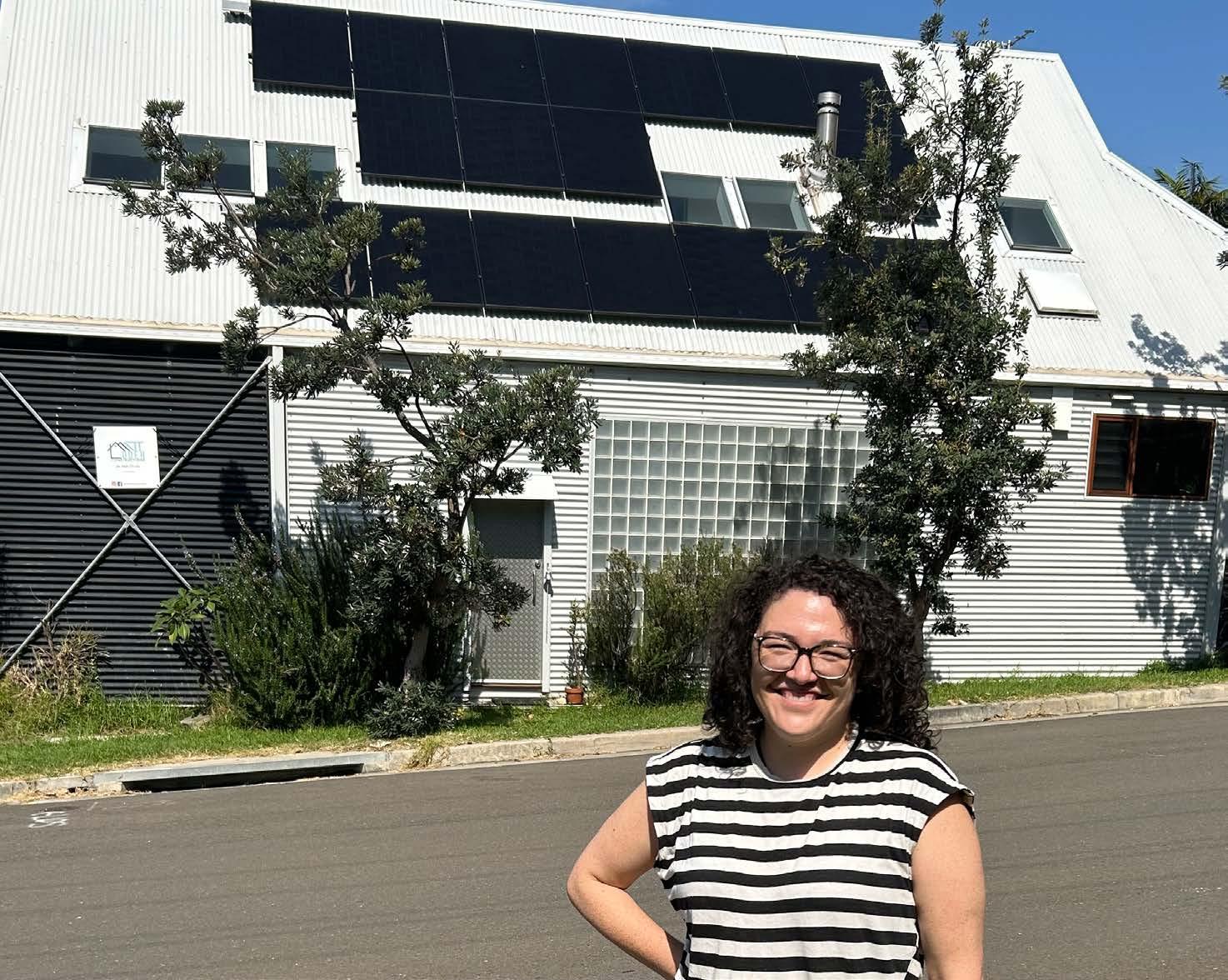
“These rules were optimised for the old fossil-fuelled economy, and they are not keeping pace with the clean energy transition.”
– Ty Christopher & Dr Vikki McLeod
Weall expect the lights to come on when we flick the switch. Have you ever stopped to think about the many rules, regulations, and organisations that keep the lights on? What does it take to change these rules? Where do vested interests lie? How does this impact your electricity bill?
Multiple regulatory bureaucracies govern and oversee the delivery of a reliable supply of electricity and how we pay for that supply here in Australia. The delivery of electricity to your home is defined by complex rules and regulations that take years to change. The rules define what is valued and what is not.
These rules were optimised for the old fossil-fuelled economy, and they are not
keeping pace with the clean energy transition.
To explain how this works, let’s think of the electricity market as a team sport. You have a team of players, each with unique strengths and weaknesses.
A coach is responsible for rotating players so the best players are always on the field. There is a referee. There is a governing body setting out the rules. There are the fans.
In Australia’s electricity market, the players are the electricity generators, and traditionally, they have been a handful of large coal and gas-fired power generators. The Australian Energy Market Operator (AEMO) acts as the onfield referee, dealing with issues as they
happen and generally trying to keep the game moving along. The Australian Energy Market Commission (AEMC) acts as the “coach”, ensuring everyone plays by the rules, advises on the team development, and suggests changes as needed. The Australian Energy Regulator (AER) is the rule keeper and rule enforcer handling any rule violations, just like the governing body of any sports code.
Then there are the energy consumers – such as households – who we can think of as the fans. They pay to be there but historically have had no real influence on the rules or how the game is played. Having a rule maker, a referee, and a judiciary for a game is fine. But the rules for the old game are dated, the old players are sluggish, the game is not as competitive anymore, and the fans are not paying to attend. We know we could be international champions if we get the rules right and put the new competitive players up front.
But the question is, are we moving fast enough to put our best team on the field and keep the fans onside? Every day Australia plays by the old rules, we lose competitiveness, and the cost of electricity bills increases. The fans aren’t happy, and they want something done to make the game cheaper, cleaner and fairer. The new players want a fair deal. With the cost of household technologies such as solar panels, heat pumps and batteries falling, energy consumers are no longer spectators but also players in the game. The fans want to feel welcomed in their support for the new game.
There is a slow realisation that the club’s business model has to change. The exclusive members will grumble and try to slow things down. But without the fans, there won’t be a club. The game has already moved on.
Australia has an entire system of rules and regulations and a supporting bureaucracy for those rules and
regulations, which are all perfectly designed for an energy system that no longer exists.
More homes and businesses are adopting clean energy technology, such as solar, batteries and electric vehicles. Large-scale renewables, such as wind farms, solar farms and big batteries, are connecting to the grid at an accelerating rate. This is transforming where and how our energy is generated. It has disrupted the economics of the electricity market and highlighted the need to transform the grid into a smart grid.
Other countries have been successful in reforming their electricity markets, and Australia has now met the same preconditions for reforming our electricity market.
The Australian energy landscape is changing rapidly. To keep pace, we need to allow for greater regulatory agility and innovation. We need the coach, the referee, and governing body to work alongside the new players and the fans to co-design a new rule book rather than changing one rule at a time.
We need to create opportunities for the market to realign. So, we need places and spaces like ‘Local Renewable Energy Zones’ to test and sandbox the new rules.
Rewiring Australia is creating this opportunity via community-level electrification pilots, such as Electrify 2515.
We need to value the end consumers’ role in the future electricity system. We need to create local energy markets where consumers can trade the essential energy services that they can provide to the electricity grid. We need to design the rules for a cleaner and cheaper energy future that puts energy consumers at the centre of effective reform.
If we do this, we will all enjoy the benefits of a cheaper, cleaner and fairer energy system.
Dr Vikki McLeod leads the energy market reform work at Rewiring Australia. Ty Christopher is Director of the Energy Futures Network at the University of Wollongong.
Click to read the full story on the Flame’s website
By Simone Potter, the director of Bush Magic Adventure Therapy

Formost parents, sending their children to school is a given, something that all children do and a part of life so natural that they never question whether there is another way. And for most kids, school is fine and contributes to the child’s wellbeing as they learn social skills and other non-academic life lessons alongside their peer group.
But what if your child is different?
What if your child just doesn’t fit in or struggles to learn or behave as expected and ends up feeling like a failure just for being themselves?
What if they are bullied and the school doesn’t respond in a supportive way that keeps your child safe and they begin having problems getting up in the morning as their motivation for school and for life wanes?
There are a growing number of parents who are seeing that mainstream schooling options are not right for their child.
The levels of childhood depression and anxiety, diagnosis of ADHD and ASD, school refusal or school ‘can’t’ have risen dramatically, especially since the Covid lockdowns ended. Children who were happy learning at home, where they didn’t have to deal with the complexities of social situations in the playground, those finding teacher expectations impossible to follow or battling workloads not aligned with their interests are many of the children who are now finding alternatives in approaches such as home schooling, alternative schooling and even unschooling.
As a provider of an alternative educational program, I am often asked how we make sure children learn in our programs. To me, that question is both easy and difficult to answer. Of course, Bush
Or what if, as a parent, your experience at school left you with deep scars that have led you to search for alternatives for your own children’s education?
children learn every day. I challenge any parent or teacher to step back and just watch one day, instead of feeling the need to jump in and ‘teach’.
When children are left to their own devices and encouraged to learn what they are interested in through play, amazing things happen. They become interested, they get their individual sparkle back, they become passionate again and they can’t stop learning!
And with the support of the adult teachers and role models around them, they can learn much more than they may have learned at school and become motivated even to study things they don’t particularly enjoy if they see that it may further their learning of a topic they are passionate about.
They may not learn about particular topics in geography or history, but maybe they will. They may not learn advanced maths, but maybe they will. They may not learn music or art, but maybe they will. And when you think about it, what is it that we really need to know when we are through school? The only things that are really important when it comes to academic learning contributing to general life are the ability to read and to do basic maths. We can achieve both these things by mid primary school.
Emotional intelligence, social skills, resilience to get through life’s challenges,
knowing how to use your strengths and how to admit defeat and lose gracefully, how to assess risky situations and how to rise to worthwhile challenges, these skills are probably a lot more important than many of the things we are taught at school and told we must know.
The question of how we make sure children are learning is also difficult to answer because I can only think of the alternative – how can we stop children learning? We can’t. They will learn no matter what.
We just need to provide them with the right conditions to learn in a healthy and positive way, the belief in themselves to know that they are capable of learning and the resources and encouragement to try things out for themselves.
So if your child is struggling at school, there are alternatives. It may not be as drastic as needing to pull them out entirely – many children who attend my programs at Bush Magic come one day a week and still attend mainstream school – but don’t be scared to think outside the box and consider things that you may not have considered before.
You may be pleasantly surprised at the impact of some small changes on your child’s mental health and belief in themselves, and the big impact these changes can have on their wellbeing and motivation to learn something new.
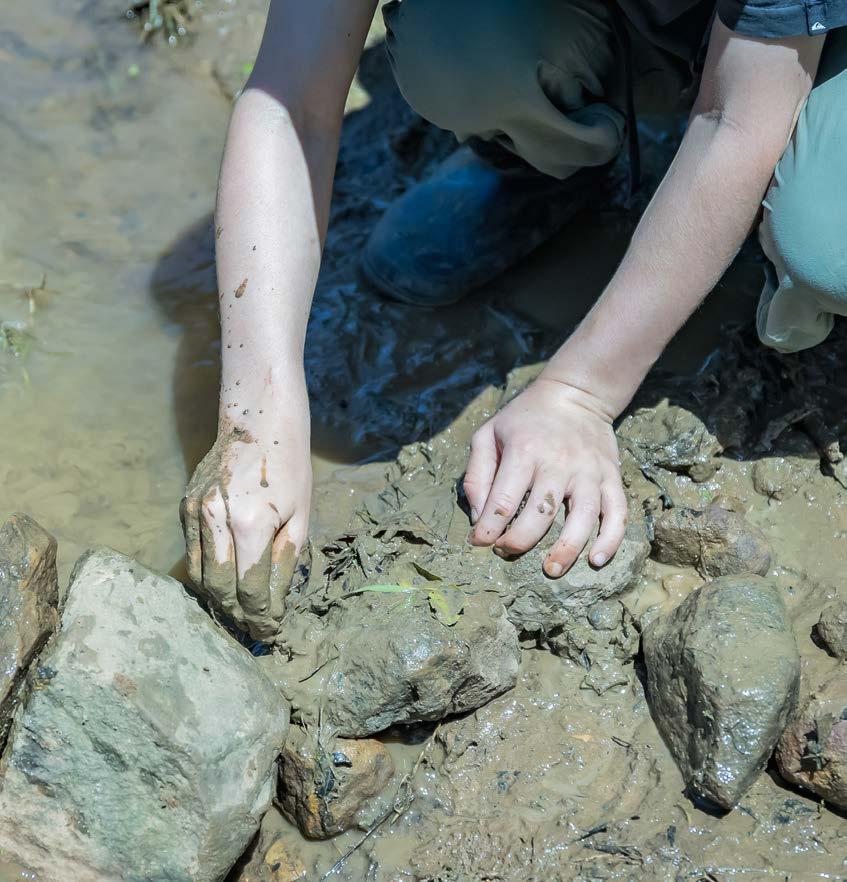
“There are a growing number of parents who are seeing that mainstream schooling options are not right for their child.”
– Simone Potter
